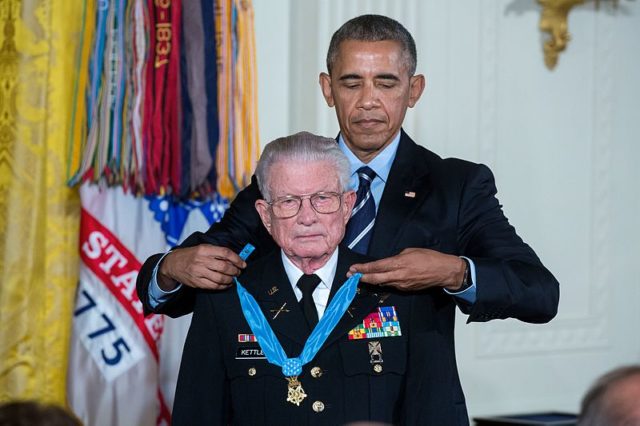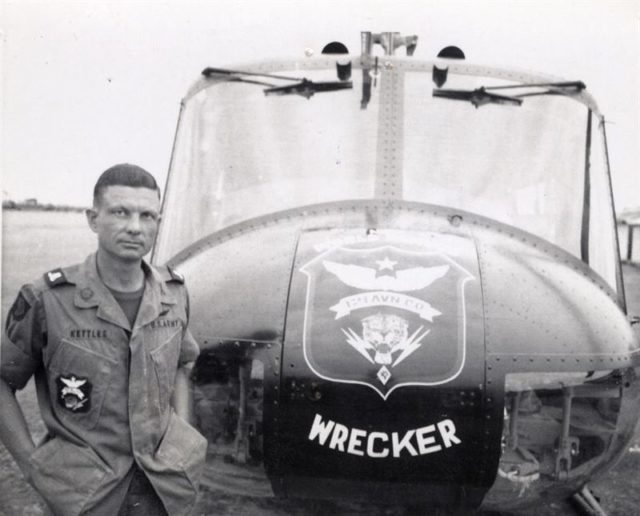After more than five decades, the heroism of Charles Kettles has received the recognition that he long sought after; the long-forgotten details of the Kettles’ bravery are now in the spotlight after he was awarded his Medal of Honour at White House by President Barack Obama.

Born in Ypsilanti, Michigan, on January 9th, 1930, the now retired Lieutenant-colonel Charles S. Kettles had aviation in his DNA. Kettles’ father took part in the First World War as a Royal Air Force Pilot (in Canada), and in the Second World War as Air Transport Command Pilot for U.S. Army Air Corps. Kettles had the opportunity to realize his passion for flying during his time at Edison Institute High School in Dearborn, where he honed his flying skills using Ford Motor-Flight Department simulators.
After his high school graduation, Kettles went on to enroll in the Michigan State Normal College (now known as Eastern Michigan University) to study engineering. Kettles was drafted into the Army at the age of 21, merely two years after he first set foot in Michigan College. After the successful completion of basic training at Camp Breckinridge, Kentucky, Kettles joined the Officer Candidate School at Fort Knox, from where he successfully earned commission on Feb. 28, 1953, as an Armor officer in the U.S. Army Reserve. Upon his return in 1956, Kettles decided to set an up a Ford Dealership in partnership with his brother in Dewitt, Michigan. However, he stayed active with Army Reserve as part of 4th Battalion, 20th Field Artillery.

When in 1963 United States got actively involved in Vietnam War, Kettles volunteered for the active duty considering his Fixed-wing qualification and the fact that the US desperately needed qualified and willing pilots. Soon after that in 1964, he attended the Helicopter Transition Training near Fort Wolters in Texas. In 1965 Kettles visited France to attend cross-training to fly the famous UH-1D.
Kettles received the information about an intense ambush taking place in the mountains near Song Tra Cau where personnel from 1st Brigade, 101st Airborne Division were surrounded and pinned down by a battalion-sized force of North Vietnamese fighters. Kettles volunteered to lead a group of six UH-1D helicopters on a reinforcement and rescue mission.
Arriving in the area, the helicopters came under heavy fire from the Vietnamese, who were deeply embedded in a series tunnels under the surrounding ridges. Despite this, Kettles managed to land, unloading much-needed reinforcements for the Americans and evacuating the wounded men. After refueling and re-arming, he returned a second time to deliver more troops to the battle. This time, his Kettles was met with a storm of small-arms and mortar fire that seriously wounded his gunner and damaged his helicopter. Despite leaking fuel, he managed to get the damaged aircraft to safety.
Later that day, orders came for emergency evacuation of 40 men who were stranded in the mountains, and Kettles was again quick and keen to volunteer. For the third, he led a rescue mission into the extremely hostile area. He landed successfully, and after being assured that all of the men onboard, Kettles led the helicopters back to base. It was only when he landed that he was told eight men had been left behind – they were pinned down by intense enemy fire and had been unable to get to the landing zone.
Kettles decided to head back to get the remaining soldiers from the battlefield, this time on his own and without any gunship air support. At the sight of the lone aircraft, the Vietnamese focussed all their firepower onKettles’ helicopter and badly damaged it. Despite taking a direct hit from a mortar and being raked by machine gun fire, Kettles managed to pull out the remaining soldiers and safely land back on the base. If it were not for the bravery, courage, and immaculate flying skills of Charles Kettles, those men would have never been able to escape the ordeal alive.
